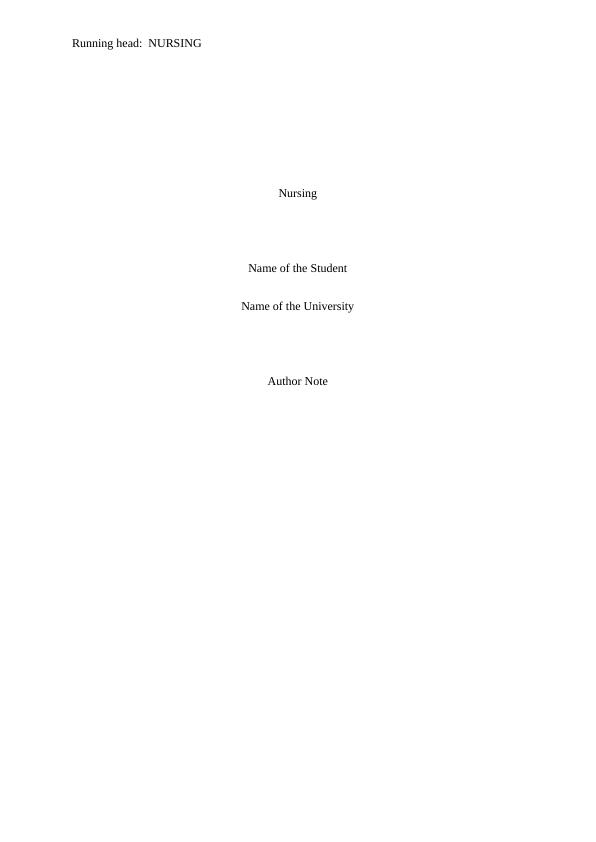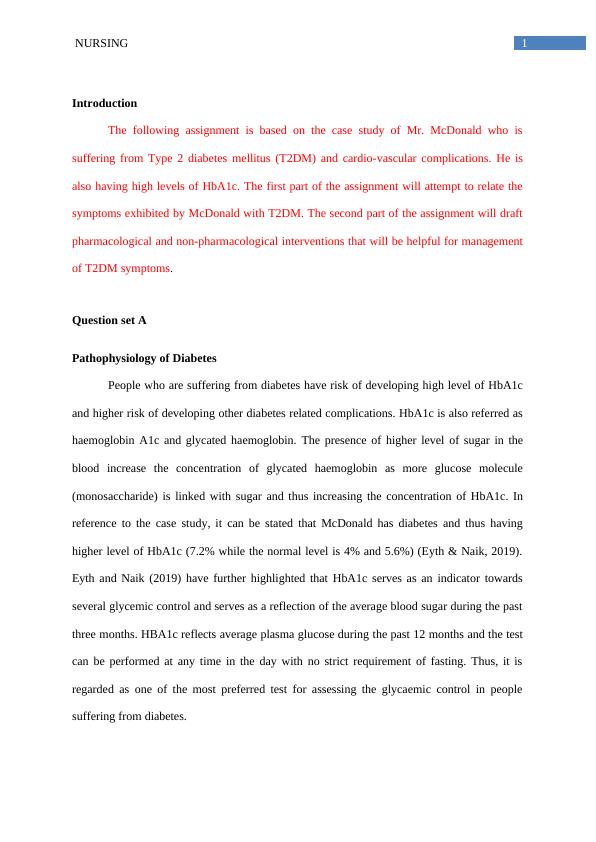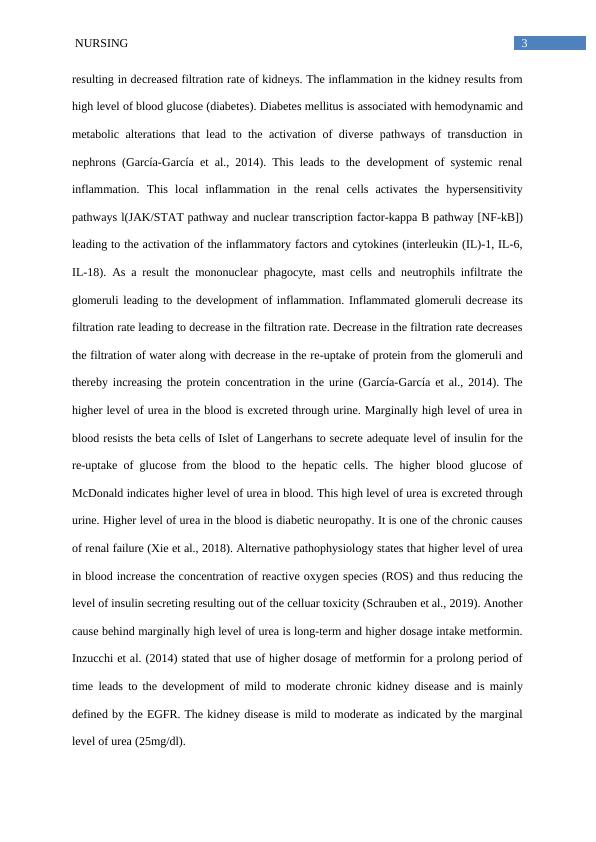Pathophysiology of Diabetes | Case Study Report
Write an essay on Case Bill McDonald, a 75-year-old male patient with type 2 diabetes and other health issues.
11 Pages2897 Words20 Views
Added on 2022-08-20
Pathophysiology of Diabetes | Case Study Report
Write an essay on Case Bill McDonald, a 75-year-old male patient with type 2 diabetes and other health issues.
Added on 2022-08-20
ShareRelated Documents
Running head: NURSING
Nursing
Name of the Student
Name of the University
Author Note
Nursing
Name of the Student
Name of the University
Author Note

1NURSING
Introduction
The following assignment is based on the case study of Mr. McDonald who is
suffering from Type 2 diabetes mellitus (T2DM) and cardio-vascular complications. He is
also having high levels of HbA1c. The first part of the assignment will attempt to relate the
symptoms exhibited by McDonald with T2DM. The second part of the assignment will draft
pharmacological and non-pharmacological interventions that will be helpful for management
of T2DM symptoms.
Question set A
Pathophysiology of Diabetes
People who are suffering from diabetes have risk of developing high level of HbA1c
and higher risk of developing other diabetes related complications. HbA1c is also referred as
haemoglobin A1c and glycated haemoglobin. The presence of higher level of sugar in the
blood increase the concentration of glycated haemoglobin as more glucose molecule
(monosaccharide) is linked with sugar and thus increasing the concentration of HbA1c. In
reference to the case study, it can be stated that McDonald has diabetes and thus having
higher level of HbA1c (7.2% while the normal level is 4% and 5.6%) (Eyth & Naik, 2019).
Eyth and Naik (2019) have further highlighted that HbA1c serves as an indicator towards
several glycemic control and serves as a reflection of the average blood sugar during the past
three months. HBA1c reflects average plasma glucose during the past 12 months and the test
can be performed at any time in the day with no strict requirement of fasting. Thus, it is
regarded as one of the most preferred test for assessing the glycaemic control in people
suffering from diabetes.
Introduction
The following assignment is based on the case study of Mr. McDonald who is
suffering from Type 2 diabetes mellitus (T2DM) and cardio-vascular complications. He is
also having high levels of HbA1c. The first part of the assignment will attempt to relate the
symptoms exhibited by McDonald with T2DM. The second part of the assignment will draft
pharmacological and non-pharmacological interventions that will be helpful for management
of T2DM symptoms.
Question set A
Pathophysiology of Diabetes
People who are suffering from diabetes have risk of developing high level of HbA1c
and higher risk of developing other diabetes related complications. HbA1c is also referred as
haemoglobin A1c and glycated haemoglobin. The presence of higher level of sugar in the
blood increase the concentration of glycated haemoglobin as more glucose molecule
(monosaccharide) is linked with sugar and thus increasing the concentration of HbA1c. In
reference to the case study, it can be stated that McDonald has diabetes and thus having
higher level of HbA1c (7.2% while the normal level is 4% and 5.6%) (Eyth & Naik, 2019).
Eyth and Naik (2019) have further highlighted that HbA1c serves as an indicator towards
several glycemic control and serves as a reflection of the average blood sugar during the past
three months. HBA1c reflects average plasma glucose during the past 12 months and the test
can be performed at any time in the day with no strict requirement of fasting. Thus, it is
regarded as one of the most preferred test for assessing the glycaemic control in people
suffering from diabetes.

2NURSING
The case study highlights that McDonald has developed pitting oedema in both the
lower legs. Oedema is defined as fluid build-up in the body or water retention that leads to
swelling. It mainly affects the lower extremity of the body and thus also known as peripheral
oedema. The pathophysiology underlying the fluid retention is difficult to isolate and might
be an indicator to secondary to multiple etiologies. Diabetes is a string yet independent risk
factor of oedema and use of antihyperglycemic drug, in this case Metformin (500 mg oral
twice daily later 1000 mg) (Wu et al., 2017). McDonald was diagnosed with diabetes 1 year
ago with HbA1c level is 7.2% and fasting glucose is 4.5 to 7 mmol/L. This high level of
glucose in the blood increase the risk of developing micro and macrovascular complications
of diabetes. Under macor-vascular complications of diabetes, there occurs deposition of
cholesterol over the peripheral capillaries (arthrosclerosis). This leads to reduction in the
overall diameter of the capillaries causing restriction in the flow of blood. The restriction in
the flow of the blood towards the peripheral regions of the legs creates pressure over the total
surface areas of the capillaries. As a result of this pressure, the capillary walls leak resulting
in the inflow of the extracellular fluid inside the capillary cells causing swelling or oedema.
McDonald used to consume heavy alcohol and this further aggravated the chance of
developing arthrosclerosis (Wu et al., 2017).
The urine analysis of McDonald indicated high level of protein (4+). Blood serum test
of McDonald indicated the presence of urea (25 mg/dl) along with the serum albumin (6.1
mg/dl). Decreased Estimated Glomerular Filtration Rate (EGFR) was observed and 24 hours
urine test highlighted higher urine albumin excretion in comparison to the normal rate. All
these condition indicated the presence of proteinuria. The detection of protein in the urine is
an indicator of renal disease. McDonald was also suffering from renal disease and this is
evident from the decreased EGFR. Decreased EGFR is attributable to the formation of
glomerulonephritis. The glomerulonephritis is defined as inflammation n the kidneys
The case study highlights that McDonald has developed pitting oedema in both the
lower legs. Oedema is defined as fluid build-up in the body or water retention that leads to
swelling. It mainly affects the lower extremity of the body and thus also known as peripheral
oedema. The pathophysiology underlying the fluid retention is difficult to isolate and might
be an indicator to secondary to multiple etiologies. Diabetes is a string yet independent risk
factor of oedema and use of antihyperglycemic drug, in this case Metformin (500 mg oral
twice daily later 1000 mg) (Wu et al., 2017). McDonald was diagnosed with diabetes 1 year
ago with HbA1c level is 7.2% and fasting glucose is 4.5 to 7 mmol/L. This high level of
glucose in the blood increase the risk of developing micro and macrovascular complications
of diabetes. Under macor-vascular complications of diabetes, there occurs deposition of
cholesterol over the peripheral capillaries (arthrosclerosis). This leads to reduction in the
overall diameter of the capillaries causing restriction in the flow of blood. The restriction in
the flow of the blood towards the peripheral regions of the legs creates pressure over the total
surface areas of the capillaries. As a result of this pressure, the capillary walls leak resulting
in the inflow of the extracellular fluid inside the capillary cells causing swelling or oedema.
McDonald used to consume heavy alcohol and this further aggravated the chance of
developing arthrosclerosis (Wu et al., 2017).
The urine analysis of McDonald indicated high level of protein (4+). Blood serum test
of McDonald indicated the presence of urea (25 mg/dl) along with the serum albumin (6.1
mg/dl). Decreased Estimated Glomerular Filtration Rate (EGFR) was observed and 24 hours
urine test highlighted higher urine albumin excretion in comparison to the normal rate. All
these condition indicated the presence of proteinuria. The detection of protein in the urine is
an indicator of renal disease. McDonald was also suffering from renal disease and this is
evident from the decreased EGFR. Decreased EGFR is attributable to the formation of
glomerulonephritis. The glomerulonephritis is defined as inflammation n the kidneys

3NURSING
resulting in decreased filtration rate of kidneys. The inflammation in the kidney results from
high level of blood glucose (diabetes). Diabetes mellitus is associated with hemodynamic and
metabolic alterations that lead to the activation of diverse pathways of transduction in
nephrons (García-García et al., 2014). This leads to the development of systemic renal
inflammation. This local inflammation in the renal cells activates the hypersensitivity
pathways l(JAK/STAT pathway and nuclear transcription factor-kappa B pathway [NF-kB])
leading to the activation of the inflammatory factors and cytokines (interleukin (IL)-1, IL-6,
IL-18). As a result the mononuclear phagocyte, mast cells and neutrophils infiltrate the
glomeruli leading to the development of inflammation. Inflammated glomeruli decrease its
filtration rate leading to decrease in the filtration rate. Decrease in the filtration rate decreases
the filtration of water along with decrease in the re-uptake of protein from the glomeruli and
thereby increasing the protein concentration in the urine (García-García et al., 2014). The
higher level of urea in the blood is excreted through urine. Marginally high level of urea in
blood resists the beta cells of Islet of Langerhans to secrete adequate level of insulin for the
re-uptake of glucose from the blood to the hepatic cells. The higher blood glucose of
McDonald indicates higher level of urea in blood. This high level of urea is excreted through
urine. Higher level of urea in the blood is diabetic neuropathy. It is one of the chronic causes
of renal failure (Xie et al., 2018). Alternative pathophysiology states that higher level of urea
in blood increase the concentration of reactive oxygen species (ROS) and thus reducing the
level of insulin secreting resulting out of the celluar toxicity (Schrauben et al., 2019). Another
cause behind marginally high level of urea is long-term and higher dosage intake metformin.
Inzucchi et al. (2014) stated that use of higher dosage of metformin for a prolong period of
time leads to the development of mild to moderate chronic kidney disease and is mainly
defined by the EGFR. The kidney disease is mild to moderate as indicated by the marginal
level of urea (25mg/dl).
resulting in decreased filtration rate of kidneys. The inflammation in the kidney results from
high level of blood glucose (diabetes). Diabetes mellitus is associated with hemodynamic and
metabolic alterations that lead to the activation of diverse pathways of transduction in
nephrons (García-García et al., 2014). This leads to the development of systemic renal
inflammation. This local inflammation in the renal cells activates the hypersensitivity
pathways l(JAK/STAT pathway and nuclear transcription factor-kappa B pathway [NF-kB])
leading to the activation of the inflammatory factors and cytokines (interleukin (IL)-1, IL-6,
IL-18). As a result the mononuclear phagocyte, mast cells and neutrophils infiltrate the
glomeruli leading to the development of inflammation. Inflammated glomeruli decrease its
filtration rate leading to decrease in the filtration rate. Decrease in the filtration rate decreases
the filtration of water along with decrease in the re-uptake of protein from the glomeruli and
thereby increasing the protein concentration in the urine (García-García et al., 2014). The
higher level of urea in the blood is excreted through urine. Marginally high level of urea in
blood resists the beta cells of Islet of Langerhans to secrete adequate level of insulin for the
re-uptake of glucose from the blood to the hepatic cells. The higher blood glucose of
McDonald indicates higher level of urea in blood. This high level of urea is excreted through
urine. Higher level of urea in the blood is diabetic neuropathy. It is one of the chronic causes
of renal failure (Xie et al., 2018). Alternative pathophysiology states that higher level of urea
in blood increase the concentration of reactive oxygen species (ROS) and thus reducing the
level of insulin secreting resulting out of the celluar toxicity (Schrauben et al., 2019). Another
cause behind marginally high level of urea is long-term and higher dosage intake metformin.
Inzucchi et al. (2014) stated that use of higher dosage of metformin for a prolong period of
time leads to the development of mild to moderate chronic kidney disease and is mainly
defined by the EGFR. The kidney disease is mild to moderate as indicated by the marginal
level of urea (25mg/dl).

End of preview
Want to access all the pages? Upload your documents or become a member.
Related Documents
Pathophysiology of T2DM and Treatment Optionslg...
|9
|2895
|3
Pharmacology: Managing Diabetes and High Cholesterol Levelslg...
|8
|2300
|388
Diabetic Foot Ulcer: Pathophysiology, Nursing Interventions, and Management Strategieslg...
|12
|2965
|24
Assignment on Diabetes Mellituslg...
|8
|2896
|212
Bill McDonald - Case Study Analysislg...
|10
|3094
|54
Acute Care Nursing: Pathophysiology and Management of Hypertensive Diabetic Patientlg...
|13
|3330
|489
